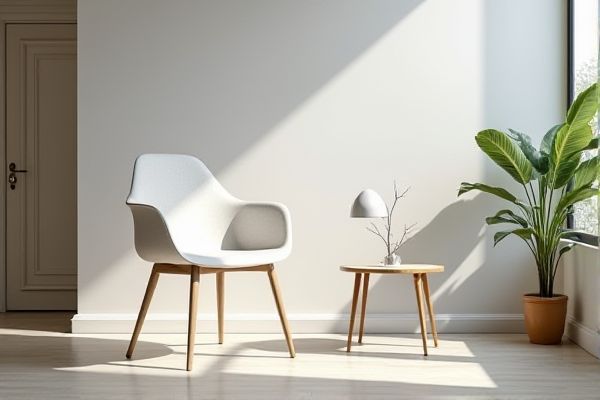
Acrylic chairs offer a sleek, modern look with superior transparency and durability compared to traditional plastic chairs, which are often less sturdy and prone to wear. Discover the key differences to help you choose the best option for your needs in the rest of this article.
Table of Comparison
| Feature | Acrylic Chair | Plastic Chair |
|---|---|---|
| Material | Poly(methyl methacrylate) - PMMA | Polypropylene or polyethylene |
| Durability | High - scratch and UV resistant | Moderate - prone to fading and cracking |
| Weight | Lightweight but sturdier | Very lightweight |
| Transparency | Clear and glass-like | Opaque or translucent |
| Design | Sleek, modern, premium look | Simple, functional designs |
| Cost | Higher price range | Budget-friendly |
| Maintenance | Easy to clean, resists stains | Easy to clean, may discolor over time |
| Environmental Impact | Less recyclable, longer lifespan | More recyclable, shorter lifespan |
Introduction: Acrylic vs Plastic Chairs
Acrylic chairs offer a sleek, modern aesthetic with exceptional transparency and durability, making them a popular choice for stylish interiors and high-traffic settings. Plastic chairs, commonly made from polypropylene or polyethylene, provide versatility, affordability, and a wide variety of colors and designs suitable for both indoor and outdoor use. When choosing your seating, consider acrylic for elegance and clarity or plastic for cost-effectiveness and weather resistance.
Material Composition: Acrylic and Plastic Compared
Acrylic chairs are made from polymethyl methacrylate (PMMA), a transparent thermoplastic known for its glass-like clarity, durability, and resistance to UV light and weathering. Plastic chairs typically utilize polypropylene or polyethylene, which are opaque, less rigid, and more prone to wear and discoloration over time. The higher density and hardness of acrylic contribute to a more premium and long-lasting seating option compared to standard plastic chairs.
Durability and Strength Differences
Acrylic chairs offer superior durability and strength compared to plastic chairs due to their high-impact resistance and ability to withstand heavy use without cracking or warping. Plastic chairs, typically made from polypropylene or polyethylene, are more prone to wear and tear, especially under prolonged exposure to sunlight and extreme temperatures. Choosing an acrylic chair ensures long-lasting performance and structural integrity, making it a reliable option for your seating needs.
Design and Aesthetic Appeal
Acrylic chairs offer a sleek, modern look with their transparent and glossy finish, enhancing spaces with a sense of lightness and sophistication. Plastic chairs provide a wide range of colors and styles, making them versatile for casual or outdoor settings but often lack the refined appearance of acrylic. The high clarity and smooth surface of acrylic chairs elevate interior design, while plastic chairs prioritize functionality and affordability over aesthetic appeal.
Comfort and Ergonomics
Acrylic chairs offer superior comfort and ergonomics due to their smooth surface and often contoured design that supports natural body posture, reducing strain during prolonged use. Plastic chairs, while lightweight and durable, typically lack ergonomic features and can cause discomfort over time because of their rigid structure and less adaptable forms. Adjustable or cushioned acrylic chairs provide enhanced support, making them preferable for extended sitting compared to standard plastic models.
Maintenance and Cleaning Requirements
Acrylic chairs require gentle cleaning with a soft cloth and mild soap to prevent scratches and maintain clarity, while plastic chairs are more durable and can withstand harsher cleaning agents and scrubbing. Both materials are resistant to moisture, but acrylic is more prone to surface damage if abrasive cleaners are used. Your choice depends on balancing the sleek appearance of acrylic with its careful maintenance needs versus the robustness and easy upkeep of plastic chairs.
Environmental Impact and Sustainability
Acrylic chairs, made from polymethyl methacrylate (PMMA), offer durability but involve energy-intensive production and limited recyclability, posing environmental challenges. Plastic chairs, often crafted from polypropylene or polyethylene, are more widely recyclable, yet their widespread disposal contributes significantly to landfill waste and microplastic pollution. Your choice between acrylic and plastic chairs affects sustainability efforts, with plastic generally offering better recyclability but both materials requiring responsible disposal to minimize ecological impact.
Price Comparison: Acrylic vs Plastic Chairs
Acrylic chairs typically cost more than plastic chairs due to the material's durability, clarity, and design versatility, with prices ranging from $100 to $300 per chair compared to plastic chairs averaging $20 to $80. The higher price of acrylic chairs reflects their premium quality, resistance to yellowing, and modern aesthetic, which is favored in upscale interiors. Plastic chairs, though budget-friendly and widely available, often sacrifice longevity and style, making them ideal for casual or temporary seating solutions.
Ideal Uses and Applications
Acrylic chairs excel in modern interior settings such as offices, dining rooms, and showrooms due to their sleek, transparent appearance and durability, offering both aesthetic appeal and comfort. Plastic chairs are highly versatile for outdoor events, casual gatherings, and budget-friendly seating solutions thanks to their lightweight, weather-resistant, and easy-to-clean properties. When choosing between the two, consider Your specific use case for durability, style, and environment to ensure optimal functionality and design integration.
Which Chair is Right for You?
Acrylic chairs offer a sleek, modern aesthetic with enhanced durability and transparency, making them ideal for stylish interiors and long-term use. Plastic chairs are lightweight, cost-effective, and versatile, suitable for outdoor settings and budget-conscious buyers. Choosing the right chair depends on your priorities for design, durability, and intended environment.
 homyna.com
homyna.com